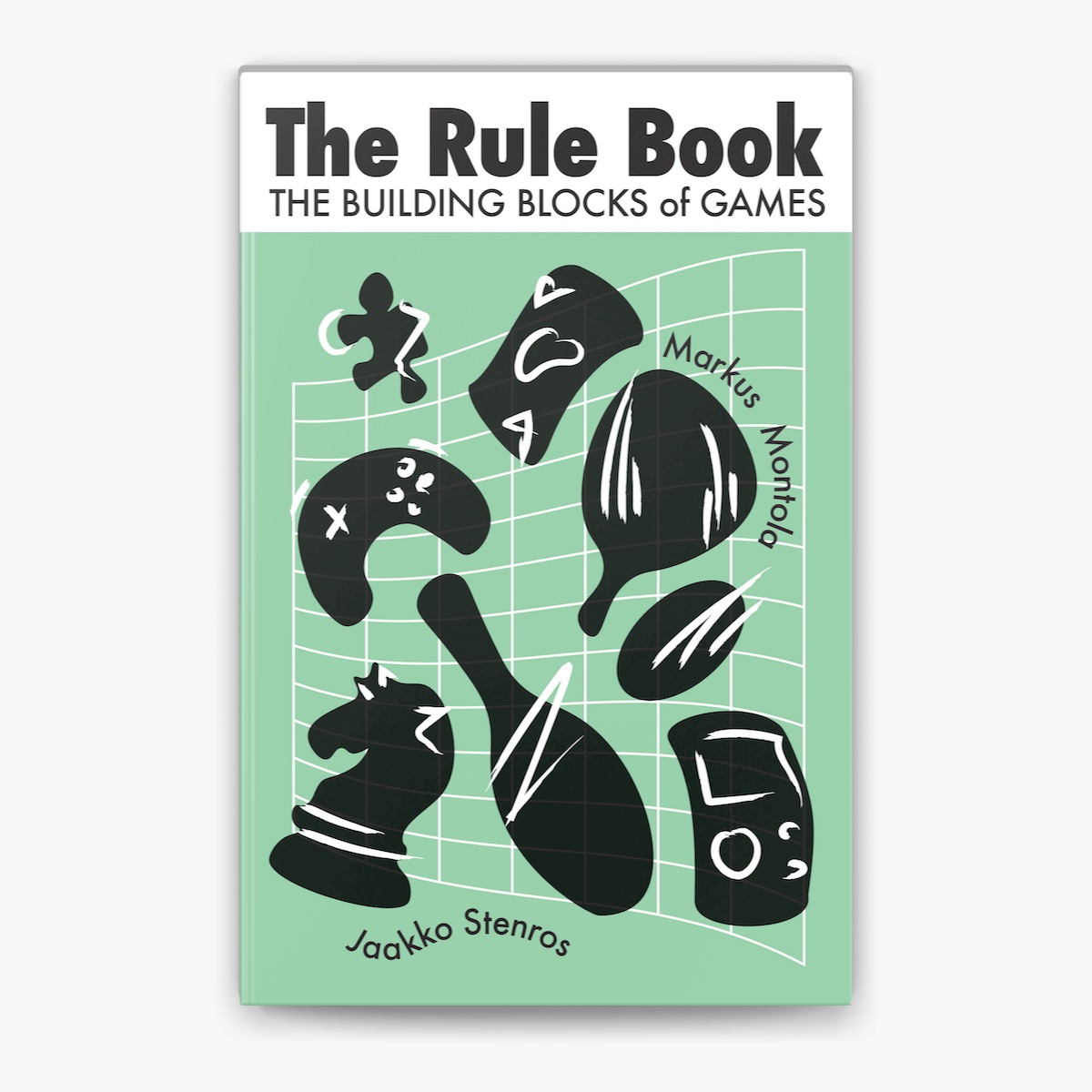Jaakko Stenros and Markus Montola. 2024. The Rule Book: The Building Blocks of Games. The MIT Press. 252 pages, Paperback. ISBN 9780262547444.
In The Rule Book: The Building Blocks of Games, Jaakko Stenros and Markus Montola masterfully “untangle the mangle of play” using their seminal constructionist ludology approach. This approach explores the boundaries surrounding play, in the context of the world around players. Each chapter after the introduction is named after one of the five categories of rules that Stenros and Montola’s metasynthesis has produced, and that they deem to be the most “analytically fruitful” categorizations.
These categories are:
- Formal rules: the explicit statements that constitute games
- Internal rules: the often private rules and goals that players set for themselves
- Social rules: the indeterminate shared social and cultural norms and values that guide gameplay
- External regulation: the rules and laws enforced by the surrounding society that impact gameplay
- Material rules: the material embodiments of rules and the ‘brute circumstances’ of play
The many definitions and explanations they give throughout the book are always necessary, timely, and serve to ground the prose in a digestible, conversational fashion. In explaining their approach, the authors presume no prior knowledge of game studies and skillfully communicate their theoretical standpoint. Those both familiar and unfamiliar with Stenros and Montola’s previous work will benefit from their practical examples, which are deployed whenever the authors introduce a new concept.
When they first introduce their five categories of rules, Stenros and Montola use the example case-study of the game pick-up sticks. Using this game, they denote how even a game globally understood to be very simple still engages with each of these five categories of rules—hence making it a game. Before playing pick-up sticks, players would have to agree on formal and material rules such as the point values of the sticks and the conditions for winning and losing. Any uncertainty during play is negotiated by social rules, values that guide social interaction and gameplay. The authors use the example of playing pick-up sticks with young children specifically. This is to illustrate one example of how adopting internal rules works in practice, by deliberately introducing “secret” rules in order to give younger players a chance to win while still keeping the game exciting and challenging for other players.
Stenros and Montola address early in the text that, within the realm of game studies, the “default case” of games is often either a digital game or a board game. They resolve to shift between these two modes of play across each chapter as they focus on different aspects of “gameness” and game rules. They alternate between sports, role-playing games, board games, digital games, virtual worlds, and esports while acknowledging the overlaps that occur between these categories. This range of examples is a huge strength of the book, as it proves that the five rule categories, while of differing importance to each type of game, are necessary across the continuum of “play” to “games.” Stenros and Montola’s conceptualization of a continuum rather than a binary serves to illustrate their core analysis that that “there is no identifiable and unambiguous formal core [to a game] that we can isolate,” and that play is the experience of a player’s interpretation and application of rules in practice. Before diving into formal rules in Chapter 1, the authors give space to explaining playfulness and play. This situates how the aforementioned continuum is marked by an “increase in complexity of social construction and rules.” Here, Stenros and Montola draw upon social constructionism to position play as an institution and rules as a mechanism for bringing about institutional facts.

In Chapter 1, the longest chapter, Stenros and Montola posit that formal rules must still be interpreted and are liable to misinterpretation, meaning that learning rules can be a “messy process.” I was surprised that they did not mention the semi-recent trend of board game rule pages beginning with a “Don’t read this! Watch this video here which explains the game!” However, there is a certain charm in having the reader make that connection for themself when surrounded by very similar ideas, such as the difference between the rules and the Learn to Play booklet that accompanies many board games. Stenros and Montola also interrogate Salen and Zimmerman’s (2004) six-quality long framework of formal rules here. They assert their position that these qualities (that rules limit player action, are explicit and unambiguous, are shared by all players, are fixed, are binding, and are repeatable across game instances) can be broken in experimental game design. The authors assert that Salen and Zimmerman’s framework only holds within the “ideal situation” of a game, and not in the practice of play. This chapter covers a remarkable amount of conditions and sub-types of formal rules, in order to consistently illustrate the practical application of these categories.
The second chapter focuses considerably more on role-playing games when evaluating internal rules: rules players set for themselves. Stenros and Montola suggest that internal rules are difficult to cite, and even that they cannot be understood in relation to formal rules alone. This chapter is especially innovative insofar as Stenros and Montola’s argument that “the idea of internal rules is tied to a specific conceptualization of “game.” The existence of internal rules fundamentally positions games as “negotiated activities” and demonstrates that “[rules] are in the process of becoming[,] through the act of playing.” Stenros and Montola argue that internal rules are rules for the reason of being in the process of becoming. I am inclined to agree, since for a condition or constraint to be a rule, it does not have to be in place all the time or in place in every instance of play. Examples of these include restricting the use of save scumming (using multiple save files to reload your progress in a game if you die), or playing Deus Ex as a pacifist throughout a run.
Chapters 3 and 4, on social rules and external regulation, stretch to virtually every corner of play and games. Social rules and external regulation are deeply interlinked, almost to the point where I question whether they are separate. Stenros and Montola define social rules as “a set of cultural codes about the conduct of play,” but in essence I believe that they are too interlinked to belong to separate categories, especially since external regulation concerns players’ rights in games, rules invoking the law, and moral judgement.
Chapter 5 perhaps has the most straightforward thesis, as the focus is on the ways in which rules are materially encoded into objects. They first give the example of Pong (1972), wherein the rules of the game are materially encoded into the software and hardware. However, in discussing the Ancient Eygptian game Senet, they assert that contemporary knowledge of the rules of Senet are conjecture based on what is encoded in the material artefacts.
Stenros and Montola also consider physical (un)realities that had never before crossed my mind. They posit that “it is only possible to materially embody rules that are possible to implement with the materials that we [now] possess” (emphasis my own). Here, they consider how 16th century Europeans could not yet bounce balls due to not having invented rubber yet, and therefore “[could not] create games that have rules that are materially embodied in a bouncing ball,” but that Mesoamerican civilizations had vulcanized rubber thousands of years before, and had played games with a rubber ball since 1400 BCE.
The Rule Book is a deeply ambitious addition to the Playful Thinking series that tackles the heart of games—rules—concisely and masterfully. For its complex subject matter, it is approachable to a very wide range of audiences and will surely be invaluable to scholars and designers alike.
–
Featured image from the cover art of The Rule Book: The Building Blocks of Games (The MIT Press).
–
Beatrix (Bea) Livesey-Stephens (she/her) is an MPhil candidate and researcher at Abertay University, where she studies player calibration in analog intimacy TTRPGs and researches European gaming clusters. Her research interests lie at the intersections of linguistics, sex and relationship education, accessibility, and ethics, in which she attempts to map the limits of transformative play and ludic vulnerability. She is also an Editorial Intern at Analog Game Studies.

